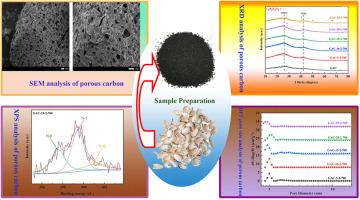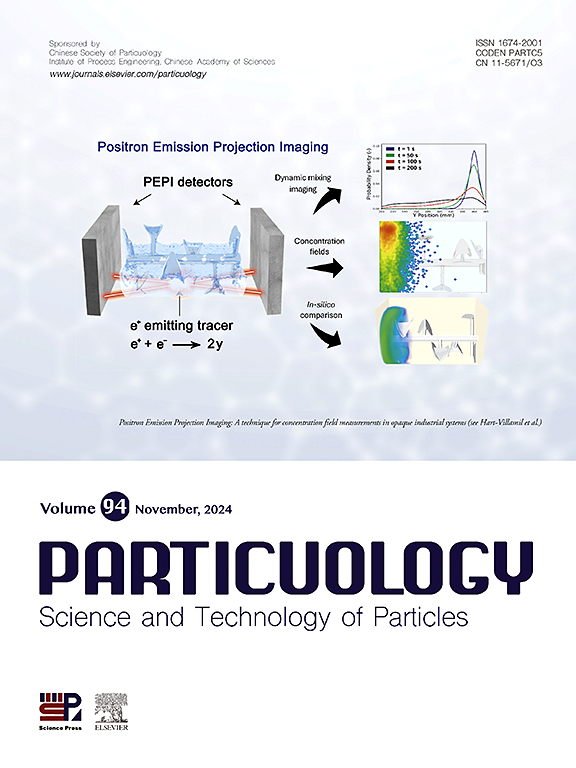Preparation of pistachio shell-based porous carbon and its adsorption performance for low concentration CO2
IF 4.1
2区 材料科学
Q2 ENGINEERING, CHEMICAL
引用次数: 0
Abstract
In this study, high-performance porous carbon for CO2 adsorption was synthesized from pistachio shells and modified with urea to enrich nitrogen content in the porous structure. The effects of activation temperature, KOH-to-carbon ratio, and urea addition on the pore structure and CO2 adsorption capacity of the porous carbon were investigated. Characterization was conducted using N2 adsorption-desorption isotherms, scanning electron microscopy (SEM), X-ray diffraction (XRD), X-ray photoelectron spectroscopy (XPS), and Fourier-transform infrared spectroscopy (FT-IR). Results showed that under preparation conditions of 700 °C, KOH-to-carbon ratio of 2, and 15 wt% urea concentration, the synthesized GAC-15-2-700 porous carbon exhibited a maximum specific surface area of 1395 m2/g, micropore volume of 0.505 cm3/g, and N-5 peak area ratio of 65.57%. It achieved a CO2 adsorption capacity of 3.56 mmol/g. Nitrogen functional groups on the porous carbon primarily existed as pyridinic N (N-6), pyrrolic/pyridinic N (N-5), and quaternary N (N-Q), with the enriched micropores and high N-5 content being crucial for CO2 adsorption.

开心果壳基多孔碳的制备及其对低浓度二氧化碳的吸附性能
本研究以开心果壳为原料合成了用于吸附二氧化碳的高性能多孔碳,并用尿素对其进行改性,以丰富多孔结构中的氮含量。研究了活化温度、KOH 与碳的比例以及尿素添加量对多孔碳孔隙结构和二氧化碳吸附能力的影响。表征采用了 N2 吸附-解吸等温线、扫描电子显微镜(SEM)、X 射线衍射(XRD)、X 射线光电子能谱(XPS)和傅立叶变换红外光谱(FT-IR)。结果表明,在 700 ℃、KOH 与碳的比例为 2、尿素浓度为 15 wt% 的制备条件下,合成的 GAC-15-2-700 多孔碳的最大比表面积为 1395 m2/g,微孔体积为 0.505 cm3/g,N-5 峰面积比为 65.57%。其二氧化碳吸附容量为 3.56 mmol/g。多孔碳上的氮官能团主要以吡啶氮(N-6)、吡咯/吡啶氮(N-5)和季氮(N-Q)的形式存在,丰富的微孔和高含量的 N-5 是吸附二氧化碳的关键。
本文章由计算机程序翻译,如有差异,请以英文原文为准。
求助全文
约1分钟内获得全文
求助全文
来源期刊

Particuology
工程技术-材料科学:综合
CiteScore
6.70
自引率
2.90%
发文量
1730
审稿时长
32 days
期刊介绍:
The word ‘particuology’ was coined to parallel the discipline for the science and technology of particles.
Particuology is an interdisciplinary journal that publishes frontier research articles and critical reviews on the discovery, formulation and engineering of particulate materials, processes and systems. It especially welcomes contributions utilising advanced theoretical, modelling and measurement methods to enable the discovery and creation of new particulate materials, and the manufacturing of functional particulate-based products, such as sensors.
Papers are handled by Thematic Editors who oversee contributions from specific subject fields. These fields are classified into: Particle Synthesis and Modification; Particle Characterization and Measurement; Granular Systems and Bulk Solids Technology; Fluidization and Particle-Fluid Systems; Aerosols; and Applications of Particle Technology.
Key topics concerning the creation and processing of particulates include:
-Modelling and simulation of particle formation, collective behaviour of particles and systems for particle production over a broad spectrum of length scales
-Mining of experimental data for particle synthesis and surface properties to facilitate the creation of new materials and processes
-Particle design and preparation including controlled response and sensing functionalities in formation, delivery systems and biological systems, etc.
-Experimental and computational methods for visualization and analysis of particulate system.
These topics are broadly relevant to the production of materials, pharmaceuticals and food, and to the conversion of energy resources to fuels and protection of the environment.
 求助内容:
求助内容: 应助结果提醒方式:
应助结果提醒方式:


